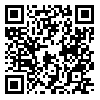Volume 8, Issue 1 (2017)
JMBS 2017, 8(1): 70-80 |
Back to browse issues page
Download citation:
BibTeX | RIS | EndNote | Medlars | ProCite | Reference Manager | RefWorks
Send citation to:



BibTeX | RIS | EndNote | Medlars | ProCite | Reference Manager | RefWorks
Send citation to:
saedi Z, gavanji S, mohabatkar H. Predicting inhibitor of anthrax toxin receptor on human cells using bioinformatics tools. JMBS 2017; 8 (1) :70-80
URL: http://biot.modares.ac.ir/article-22-1608-en.html
URL: http://biot.modares.ac.ir/article-22-1608-en.html
1- Esfahan university, sanandaj
2- Isfahan (Khorasgan) Branch, Islamic Azad University, Esfahan
3- Department of Biotechnology, Faculty of Advanced Sciences and Technologies, University of Isfahan,, Esfahan
2- Isfahan (Khorasgan) Branch, Islamic Azad University, Esfahan
3- Department of Biotechnology, Faculty of Advanced Sciences and Technologies, University of Isfahan,, Esfahan
Abstract: (7374 Views)
Abstract
Aims: Basillus anthrasis is the causative agent of anthrax that can form the highly resilient spore. Because of this attribute, it is suitable to use as biological weapon and considered as a dangerous biological bioterrorism agent. The aim of this study is to predict an inhibitor of anthrax toxin receptor on human cells by using bioinformatics tools.
Methods: The interaction between anthrax toxin receptor and 57 herbal compounds were studied by using Swissdock webserver. Then the amino acids involved in the strong interactions, were obtained by UCSF Chimera software.
Results: According to the results of this study, among the investigated compounds, 10 compounds include: Asarone, Bisabolol, Chlorogenic acid, Geraniol, Harmine, Harmaline, Sulforaphane, Fluphenazine, L-catechin and D-catechin are capable of inhibiting anthrax toxin receptor. That sulforaphane is probably the most effective inhibitor.
Conclusion: Results derived from processed analyses offer laboratory researches based on these compounds to produce an effective drug against anthrax toxin.
Aims: Basillus anthrasis is the causative agent of anthrax that can form the highly resilient spore. Because of this attribute, it is suitable to use as biological weapon and considered as a dangerous biological bioterrorism agent. The aim of this study is to predict an inhibitor of anthrax toxin receptor on human cells by using bioinformatics tools.
Methods: The interaction between anthrax toxin receptor and 57 herbal compounds were studied by using Swissdock webserver. Then the amino acids involved in the strong interactions, were obtained by UCSF Chimera software.
Results: According to the results of this study, among the investigated compounds, 10 compounds include: Asarone, Bisabolol, Chlorogenic acid, Geraniol, Harmine, Harmaline, Sulforaphane, Fluphenazine, L-catechin and D-catechin are capable of inhibiting anthrax toxin receptor. That sulforaphane is probably the most effective inhibitor.
Conclusion: Results derived from processed analyses offer laboratory researches based on these compounds to produce an effective drug against anthrax toxin.
Article Type: _ |
Subject:
Biotechnology
Received: 2015/11/22 | Accepted: 2017/03/21 | Published: 2017/08/9
Received: 2015/11/22 | Accepted: 2017/03/21 | Published: 2017/08/9
| Rights and permissions | |
 |
This work is licensed under a Creative Commons Attribution-NonCommercial 4.0 International License. |







